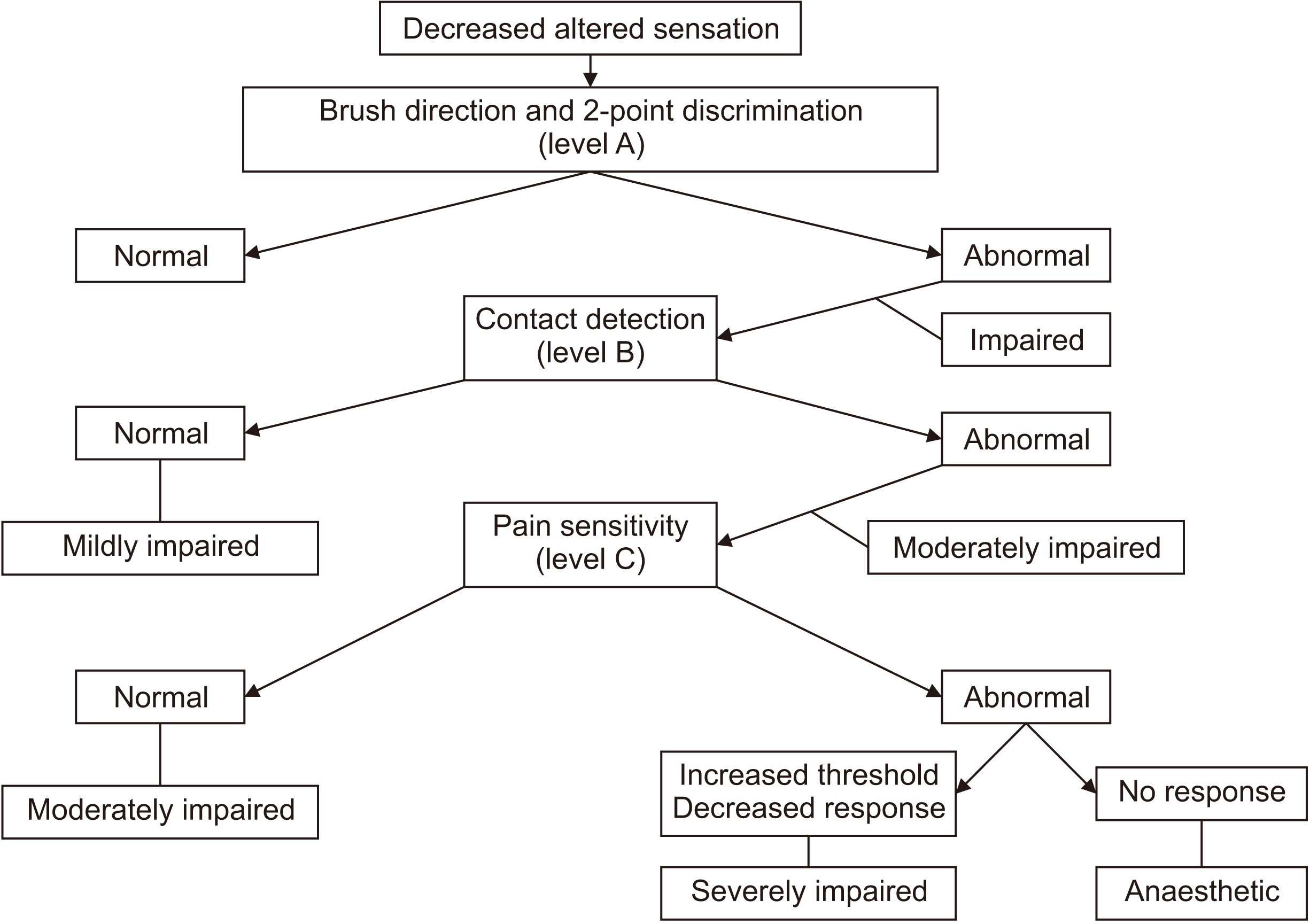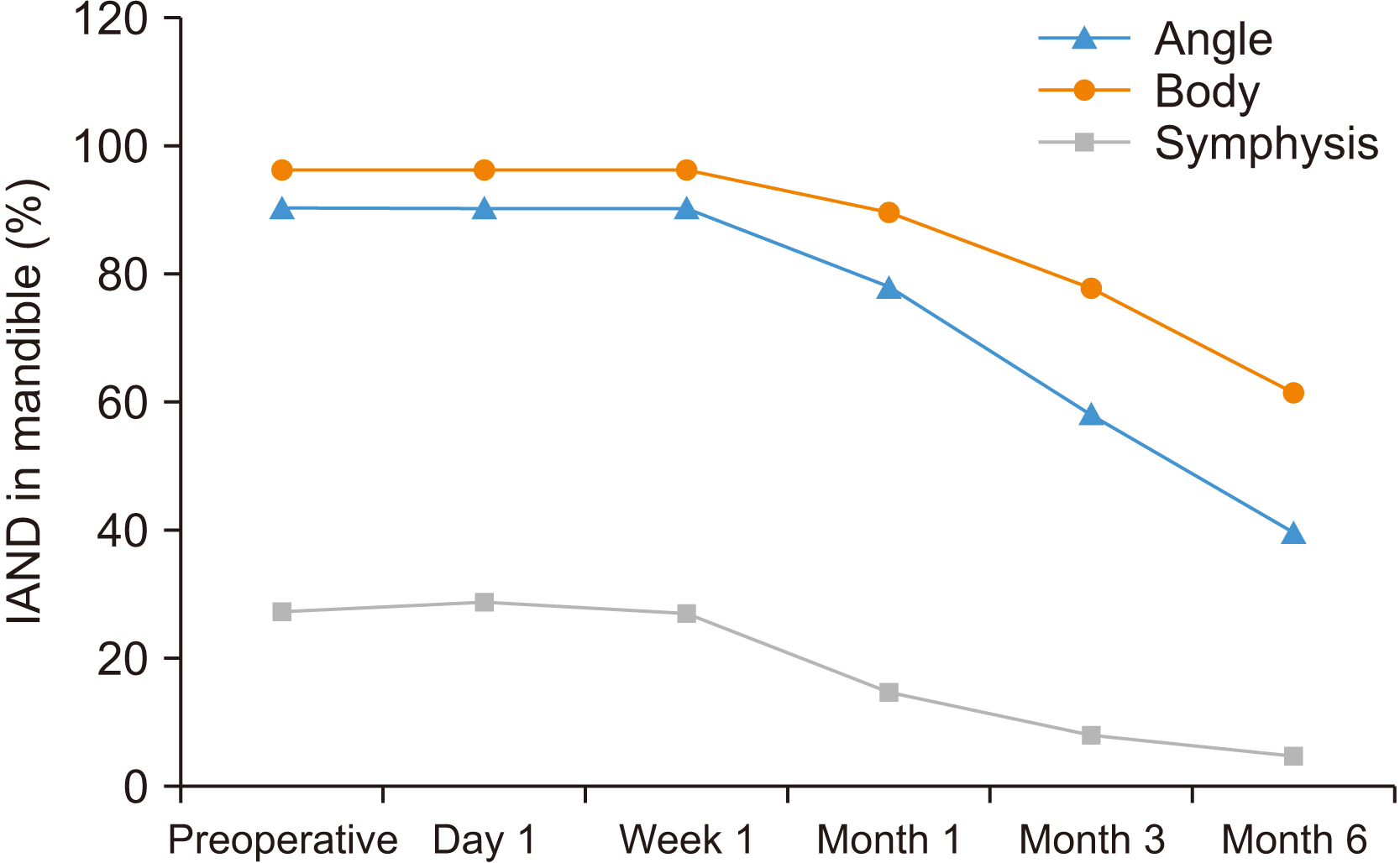J Korean Assoc Oral Maxillofac Surg.
2021 Jun;47(3):183-189. 10.5125/jkaoms.2021.47.3.183.
Inferior alveolar nerve dysfunction in mandibular fractures: a prospective cohort study
- Affiliations
-
- 1Department of Oral and Maxillofacial Surgery, JSS Dental College, JSS Academy of Higher Education and Research, Mysore, India
- 2Department of Oral and Maxillofacial Surgery, Rajarajeshwari Dental College, Bangalore, India
- KMID: 2517268
- DOI: http://doi.org/10.5125/jkaoms.2021.47.3.183
Abstract
Objectives
To assess the prevalence and recovery of inferior alveolar nerve dysfunction (IAND) in mandibular fractures.
Materials and Methods
This was a prospective cohort study. Clinical neurosensory testing was done preoperatively and the IAND was categorized as mild, moderate or severe. Postoperatively, neurosensory testing was repeated at 1 day, 1 week, 1 month, 3 months and every 3 months thereafter.
Results
A total of 257 patients with 420 fractures were included in the study with a mean age of 31.7 years. Body fractures (95.9%) had the highest incidence of IAND, followed by the angle fractures (90.1%) and symphysis fractures (27.6%). The condyle and coronoid fractures did not have any IAND and hence were excluded from further study. After eliminating those cases, 232 patients remained in the study with 293 fractures. The overall prevalence of IAND in fractures occurring distal to the mandibular foramen was 56.3%. The changes until 1 week were minimal. From 1 month to 6 months, there was a significant reduction in the severity of IAND. A significant number of cases (60.0%) were lost to follow-up between 6 and 9 months. At 6 months, 23.9% of cases still had some form of IAND and 95.0% of the symphysis, 59.0% of the angle and 34.8% of the body fractures with IAND had become normal.
Conclusion
This study documents the reduction in the degree of severity of IAND in the first six months and provides the basis for future studies with longer periods of follow-up.
Figure
Reference
-
References
1. Ellis E 3rd, Moos KF. el-Attar A. 1985; Ten years of mandibular fractures: an analysis of 2,137 cases. Oral Surg Oral Med Oral Pathol. 59:120–9. https://doi.org/10.1016/0030-4220(85)90002-7. DOI: 10.1016/0030-4220(85)90002-7. PMID: 3856795.
Article2. Halpern LR, Kaban LB, Dodson TB. 2004; Perioperative neurosensory changes associated with treatment of mandibular fractures. J Oral Maxillofac Surg. 62:576–81. https://doi.org/10.1016/j.joms.2003.12.006. DOI: 10.1016/j.joms.2003.12.006. PMID: 15122563.
Article3. Iizuka T, Lindqvist C. 1991; Sensory disturbances associated with rigid internal fixation of mandibular fractures. J Oral Maxillofac Surg. 49:1264–8. https://doi.org/10.1016/0278-2391(91)90301-2. DOI: 10.1016/0278-2391(91)90301-2. PMID: 1955918.
Article4. Thurmüller P, Dodson TB, Kaban LB. 2001; Nerve injuries associated with facial trauma: natural history, management, and outcomes of repair. Oral Maxillofac Surg Clin N Am. 13:283–93. https://doi.org/10.1016/S1042-3699(20)30144-8.
Article5. Marchena JM, Padwa BL, Kaban LB. 1998; Sensory abnormalities associated with mandibular fractures: incidence and natural history. J Oral Maxillofac Surg. 56:822–5. discussion 825–6. https://doi.org/10.1016/s0278-2391(98)90003-9. DOI: 10.1016/s0278-2391(98)90003-9. PMID: 9663571.
Article6. Coghlan KM, Irvine GH. 1986; Neurological damage after sagittal split osteotomy. Int J Oral Maxillofac Surg. 15:369–71. https://doi.org/10.1016/s0300-9785(86)80023-0. DOI: 10.1016/s0300-9785(86)80023-0. PMID: 3091714.
Article7. Zuniga JR, Essick GK. 1992; A contemporary approach to the clinical evaluation of trigeminal nerve injuries. Oral Maxillofac Surg Clin N Am. 4:353–67. https://doi.org/10.1016/S1042-3699(20)30593-8.
Article8. Tay AB, Lai JB, Lye KW, Wong WY, Nadkarni NV, Li W, et al. 2015; Inferior alveolar nerve injury in trauma-induced mandible fractures. J Oral Maxillofac Surg. 73:1328–40. https://doi.org/10.1016/j.joms.2015.02.003. DOI: 10.1016/j.joms.2015.02.003. PMID: 25914133.
Article9. Cornelius CP, Audigé L, Kunz C, Rudderman R, Buitrago-Téllez CH, Frodel J, et al. 2014; The comprehensive AOCMF classification system: mandible fractures- level 2 tutorial. Craniomaxillofac Trauma Reconstr. 7(Suppl 1):S015–30. https://doi.org/10.1055/s-0034-1389557. DOI: 10.1055/s-0034-1389557. PMID: 25489388. PMCID: PMC4251718.
Article10. Nishioka GJ, Zysset MK, Van Sickels JE. 1987; Neurosensory disturbance with rigid fixation of the bilateral sagittal split osteotomy. J Oral Maxillofac Surg. 45:20–6. https://doi.org/10.1016/0278-2391(87)90081-4. DOI: 10.1016/0278-2391(87)90081-4. PMID: 3467034.
Article11. Campbell RL, Shamaskin RG, Harkins SW. 1987; Assessment of recovery from injury to inferior alveolar and mental nerves. Oral Surg Oral Med Oral Pathol. 64:519–26. https://doi.org/10.1016/0030-4220(87)90024-7. DOI: 10.1016/0030-4220(87)90024-7. PMID: 3478632.
Article12. Song Q, Li S, Patil PM. 2014; Inferior alveolar and mental nerve injuries associated with open reduction and internal fixation of mandibular fractures: a seven year retrospective study. J Craniomaxillofac Surg. 42:1378–81. https://doi.org/10.1016/j.jcms.2014.03.029. DOI: 10.1016/j.jcms.2014.03.029. PMID: 24787242.
Article13. Boffano P, Roccia F, Gallesio C, Karagozoglu K, Forouzanfar T. 2014; Inferior alveolar nerve injuries associated with mandibular fractures at risk: a two-center retrospective study. Craniomaxillofac Trauma Reconstr. 7:280–3. https://doi.org/10.1055/s-0034-1375169. DOI: 10.1055/s-0034-1375169. PMID: 25383147. PMCID: PMC4221141.
Article14. Mayrink G, Moreira RW, Araujo MM. 2013; Prospective study of postoperative sensory disturbances after surgical treatment of mandibular fractures. Oral Maxillofac Surg. 17:27–31. https://doi.org/10.1007/s10006-012-0328-7. DOI: 10.1007/s10006-012-0328-7. PMID: 22552789.
Article15. Lone P, Kouser T, Gandral A. 2014; Response of inferior alveolar nerve to mandibular angle fractures. JK Sci. 16:62–6.16. Bede SY, Ismael WK, Al-Assaf DA, Omer SS. 2012; Inferior alveolar nerve injuries associated with mandibular fractures. J Craniofac Surg. 23:1776–8. https://doi.org/10.1097/SCS.0b013e318266fda3. DOI: 10.1097/SCS.0b013e318266fda3. PMID: 23147318.
Article17. Poort LJ, van Neck JW, van der Wal KG. 2009; Sensory testing of inferior alveolar nerve injuries: a review of methods used in prospective studies. J Oral Maxillofac Surg. 67:292–300. https://doi.org/10.1016/j.joms.2008.06.076. DOI: 10.1016/j.joms.2008.06.076. PMID: 19138602.
Article18. Ghali GE, Epker BN. 1989; Clinical neurosensory testing: practical applications. J Oral Maxillofac Surg. 47:1074–8. https://doi.org/10.1016/0278-2391(89)90184-5. DOI: 10.1016/0278-2391(89)90184-5. PMID: 2677276.
Article19. Yadav S, Mittal HC, Malik S, Dhupar V, Sachdeva A, Malhotra V, et al. 2016; Post-traumatic and postoperative neurosensory deficits of the inferior alveolar nerve in mandibular fracture: a prospective study. J Korean Assoc Oral Maxillofac Surg. 42:259–64. https://doi.org/10.5125/jkaoms.2016.42.5.259. DOI: 10.5125/jkaoms.2016.42.5.259. PMID: 27847733. PMCID: PMC5104867.
Article20. Schultze-Mosgau S, Erbe M, Rudolph D, Ott R, Neukam FW. 1999; Prospective study on post-traumatic and postoperative sensory disturbances of the inferior alveolar nerve and infraorbital nerve in mandibular and midfacial fractures. J Craniomaxillofac Surg. 27:86–93. https://doi.org/10.1016/s1010-5182(99)80019-5. DOI: 10.1016/s1010-5182(99)80019-5. PMID: 10342144.
Article
- Full Text Links
- Actions
-
Cited
- CITED
-
- Close
- Share
- Similar articles
-
- Updates on the Inferior Alveolar Nerve Block Anesthesia
- Inferior alveolar nerve repositioning in the atrophic posterior mandibular alveolar ridge
- Avoidance of Injury to the Inferior Alveolar Nerve in Mandibular Angle Contouring; Maneuver of One Inch
- The study of evaluation to relationship between the inferior alveolar nerve and the mandibular third molar by using radiographic image
- Study On The Relationship Of The Inferior Alveolar Nerve Position Between Buccal And Lingual Side Using Ct And Orthpantomogram



